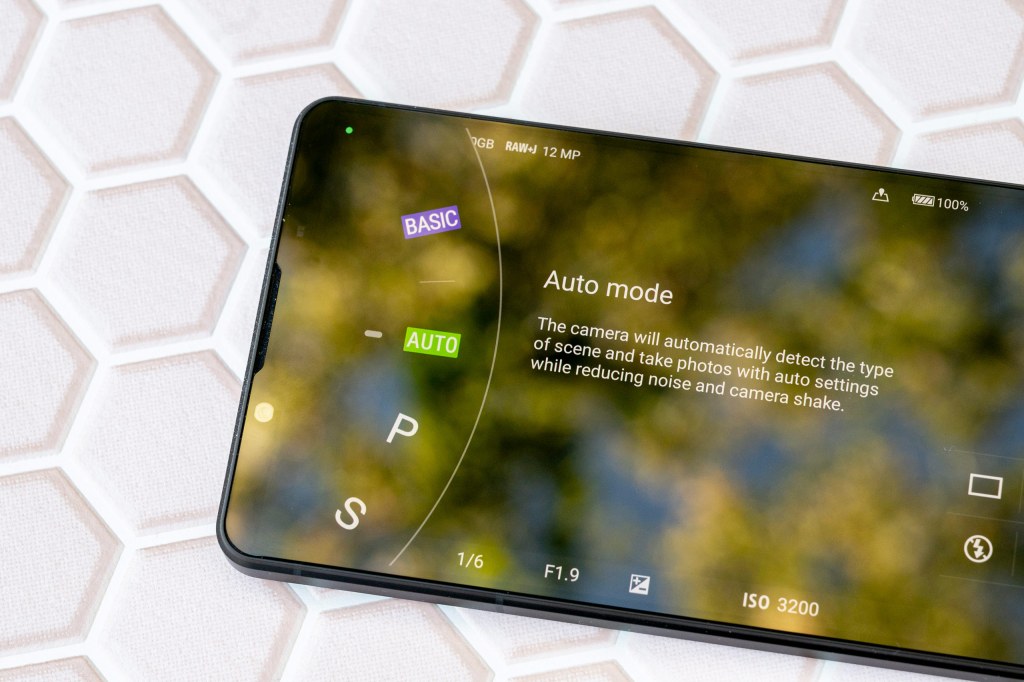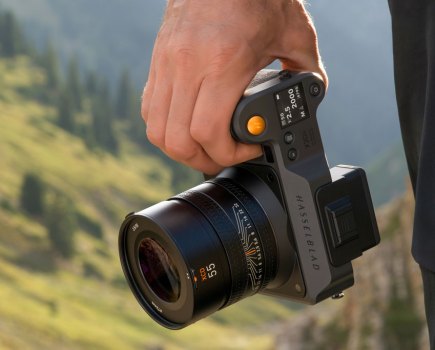The latest flagship device to hit the market is the Sony Xperia 1 V, a follow-on from last year’s Xperia 1 IV and which the company presumably hopes will help to give it some much needed market share away from the bigger players on the market. But how does it compare with some of the best phones for photography?
Sony Xperia 1 V at a glance:
- Price as reviewed: $1,398 / £1,299
- 52MP (48MP effective) wide camera, f/1.9 aperture, 24mm equivalent, PDAF, OIS
- 12MP ultra-wide camera, f/2.2 aperture, 16mm equivalent, PDAF
- 12MP optical zoom telephoto camera, f/2.3-f/2.8 aperture, 85-125mm equivalent, PDAF, OIS
- 12MP f/2.0 selfie camera, 24mm equivalent, fixed focus
- 4K video at 120/60/30/25/24fps
- Android 13
- Processor: Qualcomm Snapdragon 8 Gen 2
Sony undoubtedly makes some of the best mirrorless cameras on the market, but it’s fair to say that it hasn’t enjoyed the same kind of critical or commercial success with its range of smartphones.
We weren’t hugely impressed by last year’s Xperia 1 IV, noting a number of problems with both usability and image quality, so we’re hopeful that with some tweaks made to both, things are vastly improved for the 1 V – let’s see how that pans out.
Sony Xperia 1 V Features:
Let’s start with the camera set-up. The 1 V features a triple-lens set up, which although the same in number of lens type as the 1 IV now includes an improved main sensor.
The main sensor is now 52 megapixels (48 megapixels effective) and, new for this model, uses pixel binning to output images to 12 megapixels. The sensor is 1.7x larger than last year’s and it is joined by a 24mm equivalent f/1.9 lens, which is slightly different from last year’s f/1.7 lens. Sony promises that the new sensor is capable of delivering “higher sensitivity and lower noise” and that it is “2x better” than its predecessor in low light. This is all down to the new sensor technology found in the Sony ExmorT IMX 888.
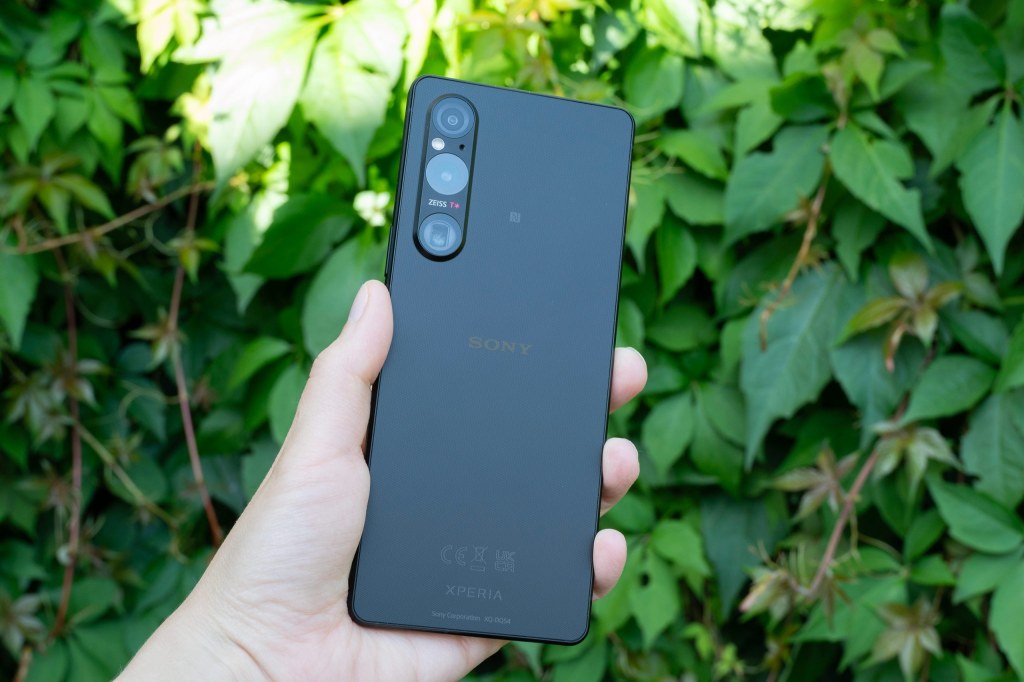
The Xperia 1 V features three lenses and an improved main camera sensor. Photo credit: Amy Davies
Sony also says that image quality is on par with a camera equipped with a full-frame sensor. When pushed to name which sensor or camera the Xperia 1 V has been benchmarked against, Sony refused to tell us – but it’s a pretty big claim nonetheless.
Another thing to say about the sensor is that it is a multi aspect ratio sensor, meaning that although the total resolution is 52 megapixels, the default usage is 48 megapixels, with around 20% of the sensor used for image stabilisation.
Both the remaining two lenses in the set-up appear to be the same as last year’s, with a 12MP ultra wide 16mm f/2.2 lens and a 12MP optical zoom lens ranging from 85-125mm and with an f/2.3-f/2.8 aperture. Although the hardware remains the same, Sony says that it has tweaked algorithms to make each of the lenses perform better. We’ll see how true that seems to be later.
We don’t have 8K video here, but we do have 4K at a range of frame rates, going all the way up to 120fps – which is relatively unusual in a smartphone. There’s also the option to record in Full HD if you prefer.
Super fast shooting of 30fps is available – an increase from last year’s 20fps. How many people actually require this level of fast shooting from a smartphone remains to be seen, but it is there regardless.
Some other features of note include the 5000mAh battery, 256GB inbuilt storage and the ability to expand that via MicroSD card, a 3.5mm audio jack for headphones, and a Snapdragon 8 Gen 2 mobile processor. A charging plug is not included in the box, so if you don’t already have one you’ll need to purchase that separately. Wireless charging is also available, again you’ll need to purchase a separate wireless charger.
It’s worth mentioning at this point that Sony doesn’t commit to supporting OS and security updates past a two year (OS) or three year (security) point. This is bad news for anyone that wants to keep their phone for a long time – or – perhaps buy it some time after the initial release.
It’s particularly disappointing compared to other manufacturers who typically offer support for much longer periods of time, and also means anybody hoping to sell an older phone when it comes to upgrade time might find the resale value seriously diminished.
Sony Xperia 1 V Handling and design:
There’s been a lot written about the design of the Xperia 1 line of phones. Here we’ve got more or less the same design as last year, with a 6.5-inch screen utilising a 21:9 display. To put that simply, it’s long and narrow – Sony says this is to give a better experience when watching films and playing games, but it’s not to everyone’s tastes. Like many other tall phones, it’s quite awkward to use for everyday tasks – especially one handed – without the benefit of the wider screen to really show off your content.
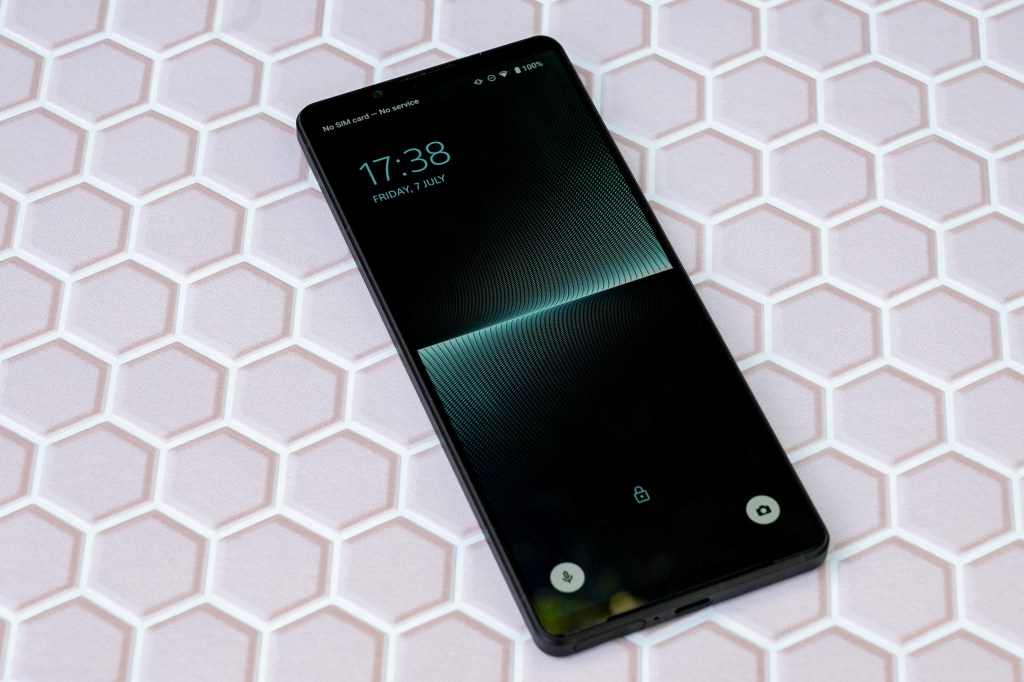
Despite its sleek design the Xperia 1 V might be difficult to use one handed. Image credit: Amy Davies
Design aesthetics are a matter of taste, but Sony plays it fairly safe – some might say boring – with the look of the 1 V. It has a texturised finish, which has the benefit of withstanding fingerprints but isn’t as shiny or attractive as some of the other Android models on the market. With squared off edges, it’s also somewhat staid – but some might like the simplicity it offers.
Whatever your feelings on looks, it benefits from Corning Gorilla Glass Victus on both the front and the back (the front has Victus 2 glass) which should mean it withstands scratches and knocks fairly well.
Native camera app:
Sony has made a couple of improvements to its native camera app since we reviewed the Xperia 1 IV, but it’s still lacking in some key areas, and frustrating to use in others.
Squarely aimed at enthusiast – and even professional – photographers, with the standard Camera Pro app, you get the choice between Basic and Auto, but also much more extensive P(rogram), S(hutter) and M(anual) modes.

Instead of a dedicated portrait mode, there is a “bokeh” option that blurs the background. Image credit: Amy Davies
In the basic mode, the Xperia 1 V is a point and shoot, the phone will take care of everything itself, and you’re also treated to an on-screen shutter button. New for this model is a Night mode, which finally makes an appearance on a Sony Xperia 1 model after many years of waiting. This should automatically activate if the phone detects there’s not much light around.
There’s still no “portrait” mode as such, but there is a “bokeh” mode which you can use to create shallow depth of field effects to give you a similar kind of look and feel to a typical “portrait” mode that you might see on other smartphones.
If you want to shoot video directly from this app, Basic mode is where you’ll need to be, and you’ll need to select video manually – there’s not the convenience of simply pressing and holding the shutter button to do that. And if you are in another shooting mode, you’ll need to come back to Basic, then select Video – this three-step process is a bit frustrating for capturing quick off the cuff movies compared to others out there.
An Auto mode is also available, which is similar to Basic mode, but includes a few more options which you can change. Here you’ll find a shutter button appears, but only if you’re shooting in portrait orientation – switch to landscape orientation and that will sadly disappear and you’ll have to use the physical button on the side of the phone (which you should position top right for the easiest way to handle it).
The big news here however is that finally Sony engineers have listened to the big gripe of previous incarnations, and the display rotates to match whichever orientation you’re shooting in. Sure, you lose/gain a shutter button, but at least you can read what you’re looking at properly.
In the Auto mode, you can change things like eye-detection, autofocusing mode, single/continuous shooting and more. If you head into the even more advanced options, you’ll be able to control things like shutter speed, white balance, metering and so on – so it really depends on how much control you want to take over each shot. It’s probably a bit overkill for most users, but it’s nice to have them here anyway. Again, in these more advanced modes, there’s no on-screen shutter button in horizontal orientation. I’m told that Sony is aware of this feedback and may do something about it for the next model. We live in hope.
Disappointingly, unlike most other flagships, there is no macro mode. It’s possible to focus fairly closely with the super-wide angle and crop in yourself after the fact, but it lacks the finesse and ease of which you can perform similar tasks with a Samsung, Google, Apple, OnePlus, Xiaomi and others.

The telephoto lens can be used for subjects such as wildlife – but the results are noticeably soft credit: Amy Davies
It’s also disappointing that despite having that super high resolution sensor, you can’t opt to shoot in high resolution mode. This is something which is readily available with most other high-resolution smartphones, so it’s not clear why Sony doesn’t want you to do that here. You have no choice but to record in 12 megapixels.
If you want to take more control over your video recording, there’s a completely separate Video Pro app, which gives you a range of extensive controls over parameters such as frame rates, resolution and more besides. Again, this is likely to be overkill for most, but for vloggers and those who want all of that control, it’s potentially appealing. Something to watch out for here is that if you use the zoom slider, you won’t be switching between lenses, you’ll be digitally zooming from the main lens. Instead, you must manually select each lens you want to use.

There are multiple ways to use the cameras on the phone, including the basic photo app, Video Pro, and Cinema Pro.
Image quality and performance:
Sony has made some bold claims when it comes to image quality with the Xperia 1 V. “Unprecedented” being one of them. In truth, it appears to be largely similar to last year’s 1 IV.
As we found before, images taken with the main (24mm) camera produce the best results, with the opportunity to create good shots in good light. Colours are fairly well represented most of the time, and the basic and auto modes does a decent job if you want to grab a snap of a not too challenging scene

Switch to manual exposure mode to gain full control over your image capture. Image credit: Amy Davies
You’ll likely find that if conditions are less than perfect – for example if it’s quite a high contrast scene, then you’ll need to switch to one of the more extensive modes and make manual adjustments as necessary.
The ultra-wide angle lens once again puts in a fairly good performance with not too much distortion and reasonably good colours and exposure.

The ultra-wide angle lens put in a good performance for landscape shots in good light Photo credit: Amy Davies
Images from both of these lenses are perfectly nice, and benefit from being matched in colour between them, but they’re not really any better than any other decent mid-range smartphone and above. It would certainly be fair to expect something a bit more impressive from something at this price point, and from a company that was making bold claims about how good image quality is.

Sony Xperia 1 V zoomed in at 85mm. Photo credit: Amy Davies
Even worse news comes from the 3.5-5.2x optical zoom lens, which is the same hardware as found in the 1 IV and despite claims that the software has been tweaked to improve performance is still disappointingly soft and smudgy. The 85mm end of the lens produces the best results, but the 125mm is best avoided unless you’re only using images at very small sizes and don’t intend to scrutinise them much, if at all.
Sony claims that it hasn’t included four lenses in the Sony Xperia 1 V to provide two different telephoto focal lengths (like we see in the Samsung Galaxy S23 Ultra) because of issues of size. This seems like a somewhat spurious claim considering how big the mechanism for a zoom lens is, but, even if totally true still doesn’t make sense.

Sony Xperia 1V zoomed in at 125mm. Photo credit: Amy Davies
It would surely be better to offer just one very good lens, even if limited in length, than one lens offering multiple focal lengths that is so poor in quality. This feels very much like a lens that is there to “prove a point” – that an optical zoom can exist within a smartphone. Nobody else on the market does it – ask yourself why that might be. It’s the Jurassic Park adage – Sony’s engineers have clearly become so obsessed with what *could* be done that they didn’t stop to think if it *should*.
Digital zoom is available as either “standard” or “AI super resolution zoom”. Super resolution zoom isn’t switched on by default as it takes longer to process images using it, but produces slightly better results in many situations – though if you’re photographing something with busy textures you might see a loss of detail. Either way, we probably wouldn’t rely on digital zoom for all that much.

With the digital zoom in use there is a drop in image quality. Photo credit: Amy Davies
Low light shooting is something which admittedly has seen a big improvement for the 1 V, as we’ve finally now got a night mode, which kicks into action in either Basic or Auto if low light is detected. You no longer need to grab a tripod and use a long exposure when light levels are low – great news. The results are reasonably good with a decent level of detail kept.
However, once again, it’s fair to say that the Xperia 1 V is not producing anything special here. The iPhone 14 Pro I had with me at the same time produced more attractive results – albeit arguably slightly less realistic. In fact, the Honor 90, a mid-range phone costing approximately one third what the Xperia 1 V will set you back, also produced more attractive results. Unprecedented image quality? Perhaps for a Sony – but not for the market as a whole.

Without a dedicated macro mode, when focusing up close the Xperia 1 V is far behind its competitors in image quality. Photo credit: Amy Davies
Although there’s no macro mode available, it’s not impossible to get close to a subject. However, the detail resolved isn’t very good, and you might see some strange halo or fringing effects. Other smartphones put in a much better performance on this front so if close-up shooting is your thing, you’ll likely be disappointed here.
For portraits, eye-AF does a good job of following a subject’s eye around the frame. But, the “bokeh” mode produces results which are a bit smudgy and unnatural looking. While nobody on the market produces “perfect” wide aperture recreations, some are better than others – and the Xperia 1 V is probably not even in the top five.

Selfie taken with Sony Xperia 1 V. Photo credit: Amy Davies
The selfie camera lags behind other flagships, as it lacks auto-focus, something you can find on other premium smartphones.
Video performance is good, with a well-performing image stabilisation system, with the main camera performing the best. You’ve also got a huge degree of control here if you want it from the Video Pro mode, which is a bonus for those who want it. For even more advanced videographers, there’s the Cinema Pro app.
Value for money
Priced at £1299, the Xperia 1 V is one of the most expensive smartphones currently on the market.
Whether that offers value for money is often down to the individual shooter. However, it’s safe to say that for a high price like that, we’d expect it to deliver on at least some of the hyperbolic promises the company makes such as “unprecedented image quality” and “comparable to full-frame” and that it would also offer all of the basic things we’d expect from a high-quality smartphone for photographers.

The new Night mode underperforms compared to other camera phones in this price range. Photo credit: Amy Davies
Sadly, image quality is lacking in certain areas – such as with the same disappointing zoom performance as last time – while others are missing altogether. There’s no macro mode, no proper portrait mode, and although Night mode has finally made an appearance, it’s still not as good as others on the market.
Sony will say that this is aimed at professionals or enthusiasts who crave being able to take control over every element of a shot and are happy to work to achieve those results. There are probably people out there who feel like that – but even the most professional of photographer is likely to want to quickly grab shots with their smartphone and not be forced to make adjustments in every single scenario.
The lack of support for OS and security updates is also a major problem for longevity, too, meaning you’ll almost certainly needing to be upgrading this phone in a couple of years at best – a shame for something costing so much in the first place.

Poor image quality when using zoom in Night mode. Photo credit: Amy Davies
Sony Xperia 1 V Verdict
In a way, you’ve got to admire Sony for keeping going in a market where it attracts so few sales. I pushed for how well the Xperia 1 V is doing in terms of units shifted, and was told this information can’t be disclosed, but it is “good”.
Without any hard data, it’s quite possible that “good” in this context means “for a Sony”. Across the globe, Apple accounts for about a third of smartphone sales, Samsung another third, and everybody else battles for the remaining third. In several markets, Sony has about 1% of the market – it seems unlikely that the big two need to feel worried about the 1 V just yet.
Although it has addressed some criticisms of its flagship model, it has done little to address many of the others. The result is we’ve still got a very highly priced phone which has features that most people don’t want or need, while missing some basic functions that most others offer, is awkwardly shaped and isn’t very attractive either. The native shooting app has handling “quirks” that are bafflingly frustrating. These could perhaps be fixed with an OS update at some point – let’s hope so.
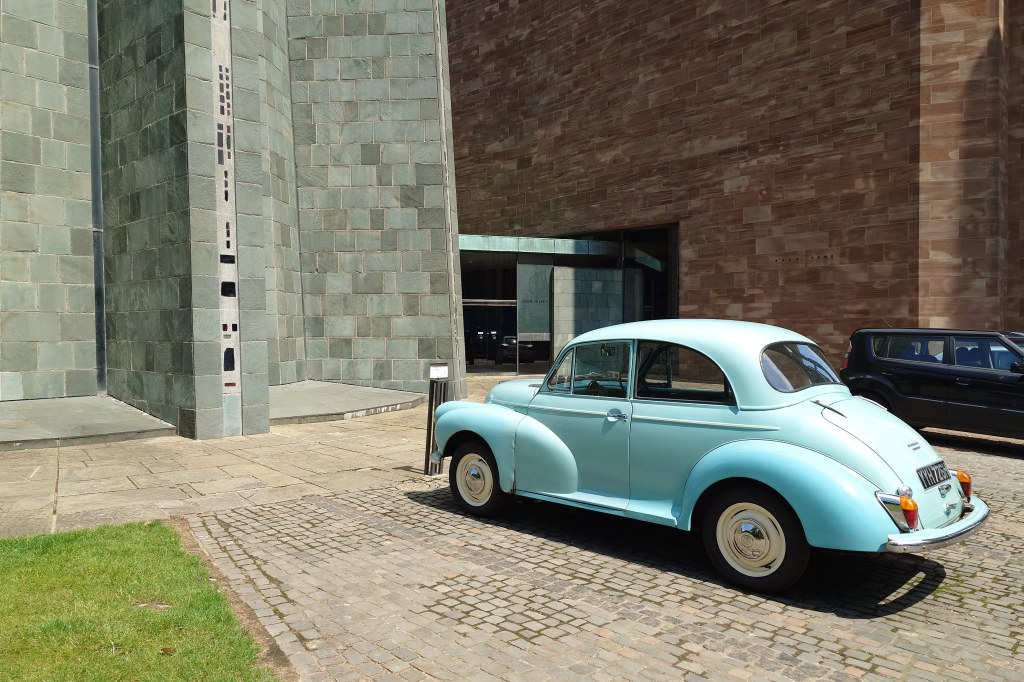
Pastel blue BMC Morris Minor 1000 – the JPEG image shows a slight green cast on this occasion. Photo credit: Amy Davies
The overall annoyance here is made all the more maddeningly frustrating when you consider that Sony makes excellent “real” cameras, screens and audio systems – some of the best on the market in fact. Why can’t it do the same for Xperia? I have made this point several times before so I won’t repeat it too much here. Xperia has its fans, but safe to say, personally I’m still disappointed.
I went into this review hoping to have had my mind changed about Xperia smartphones, and that past criticisms would have been fully addressed. Some of them have been – we’ve now got a rotating display (finally!), and a functioning night mode. But there’s still far from enough here to justify spending $1,398 / £1299 on it, and still too much basic stuff missing.
If you’re keen for a flagship smartphone and want superior image quality, lots of control, an attractive design and longer support, then the obvious answer is the Samsung Galaxy S23 or S23 Ultra. If you’re less bothered about control, go for the Pixel 7 series, or iPhone 14 Pro series if you prefer iOS.

Further reading:
- The best camera phones for photography in 2023
- Best smartphones for portrait photography
- The best budget camera phones in 2023
Follow AP on Facebook, Twitter, Instagram, YouTube and TikTok.



